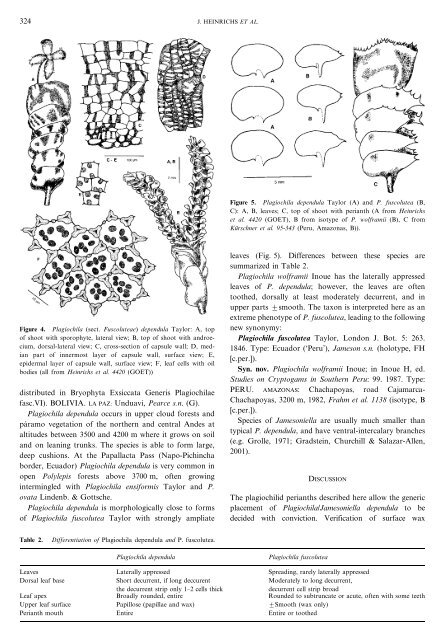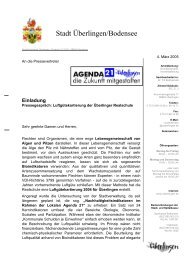The systematic position of Plagiochila - Schaefer-Verwimp
The systematic position of Plagiochila - Schaefer-Verwimp
The systematic position of Plagiochila - Schaefer-Verwimp
You also want an ePaper? Increase the reach of your titles
YUMPU automatically turns print PDFs into web optimized ePapers that Google loves.
324 J. HEINRICHS ET AL.<br />
Figure 4. <strong>Plagiochila</strong> (sect. Fuscoluteae) dependula Taylor: A, top<br />
<strong>of</strong> shoot with sporophyte, lateral view; B, top <strong>of</strong> shoot with androecium,<br />
dorsal-lateral view; C, cross-section <strong>of</strong> capsule wall; D, median<br />
part <strong>of</strong> innermost layer <strong>of</strong> capsule wall, surface view; E,<br />
epidermal layer <strong>of</strong> capsule wall, surface view; F, leaf cells with oil<br />
bodies (all from Heinrichs et al. 4420 (GOET))<br />
distributed in Bryophyta Exsiccata Generis <strong>Plagiochila</strong>e<br />
fasc.VI). BOLIVIA. LA PAZ: Unduavi, Pearce s.n. (G).<br />
<strong>Plagiochila</strong> dependula occurs in upper cloud forests and<br />
páramo vegetation <strong>of</strong> the northern and central Andes at<br />
altitudes between 3500 and 4200 m where it grows on soil<br />
and on leaning trunks. <strong>The</strong> species is able to form large,<br />
deep cushions. At the Papallacta Pass (Napo-Pichincha<br />
border, Ecuador) <strong>Plagiochila</strong> dependula is very common in<br />
open Polylepis forests above 3700 m, <strong>of</strong>ten growing<br />
intermingled with <strong>Plagiochila</strong> ensiformis Taylor and P.<br />
ovata Lindenb. & Gottsche.<br />
<strong>Plagiochila</strong> dependula is morphologically close to forms<br />
<strong>of</strong> <strong>Plagiochila</strong> fuscolutea Taylor with strongly ampliate<br />
Table 2. Differentiation <strong>of</strong> <strong>Plagiochila</strong> dependula and P. fuscolutea.<br />
Figure 5. <strong>Plagiochila</strong> dependula Taylor (A) and P. fuscolutea (B,<br />
C): A, B, leaves; C, top <strong>of</strong> shoot with perianth (A from Heinrichs<br />
et al. 4420 (GOET), B from isotype <strong>of</strong> P. wolframii (B), C from<br />
Kürschner et al. 95-343 (Peru, Amazonas, B)).<br />
leaves (Fig. 5). Differences between these species are<br />
summarized in Table 2.<br />
<strong>Plagiochila</strong> wolframii Inoue has the laterally appressed<br />
leaves <strong>of</strong> P. dependula; however, the leaves are <strong>of</strong>ten<br />
toothed, dorsally at least moderately decurrent, and in<br />
upper parts ¡smooth. <strong>The</strong> taxon is interpreted here as an<br />
extreme phenotype <strong>of</strong> P. fuscolutea, leading to the following<br />
new synonymy:<br />
<strong>Plagiochila</strong> fuscolutea Taylor, London J. Bot. 5: 263.<br />
1846. Type: Ecuador (‘Peru’), Jameson s.n. (holotype, FH<br />
[c.per.]).<br />
Syn. nov. <strong>Plagiochila</strong> wolframii Inoue; in Inoue H, ed.<br />
Studies on Cryptogams in Southern Peru: 99. 1987. Type:<br />
PERU. AMAZONAS: Chachapoyas, road Cajamarca-<br />
Chachapoyas, 3200 m, 1982, Frahm et al. 1138 (isotype, B<br />
[c.per.]).<br />
Species <strong>of</strong> Jamesoniella are usually much smaller than<br />
typical P. dependula, and have ventral-intercalary branches<br />
(e.g. Grolle, 1971; Gradstein, Churchill & Salazar-Allen,<br />
2001).<br />
DISCUSSION<br />
<strong>The</strong> plagiochilid perianths described here allow the generic<br />
placement <strong>of</strong> <strong>Plagiochila</strong>/Jamesoniella dependula to be<br />
decided with conviction. Verification <strong>of</strong> surface wax<br />
<strong>Plagiochila</strong> dependula <strong>Plagiochila</strong> fuscolutea<br />
Leaves Laterally appressed Spreading, rarely laterally appressed<br />
Dorsal leaf base Short decurrent, if long deccurent<br />
Moderately to long decurrent,<br />
the decurrent strip only 1–2 cells thick<br />
decurrent cell strip broad<br />
Leaf apex Broadly rounded, entire Rounded to subtruncate or acute, <strong>of</strong>ten with some teeth<br />
Upper leaf surface Papillose (papillae and wax) ¡Smooth (wax only)<br />
Perianth mouth Entire Entire or toothed



